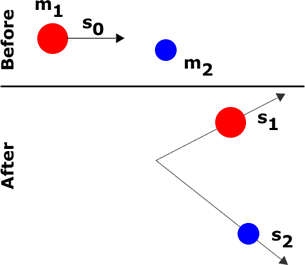| The Pre-Class Quiz questions and answers are available in pdf via the button; separate window. |
We finished §5.2, discussed §5.5, and made a good start on Chapter 6.
I stated that one might get a slightly wrong impression from Hobson about the role of atomism in the Newtonian worldview. Although forms of atomism were certainly important to the thinking of Newton and many of his contemporaries, the first "modern" statement of atomism was by Dalton in 1808. To learn more about this see:
http://plato.stanford.edu/entries/atomism-modern/
To my mind Hobson omitted one of the important threads in the Newtonian worldview: the concepts of absolute space and time. Here are some fragments from the Principia:
"Absolute space, in its own nature, without relation to anything external, remains always similar and immovable."
"Absolute, true, and mathematical time, of itself, and from its own nature, flows equably without relation to anything external, and by another name is called duration."
We will examine these concepts in much more detail when we begin discussing Einstein's Theories of Relativity.
In class I discussed the fact that the origin of what we now call the kinetic energy is actually due to Leibniz, who was a contemporary of Newton. He noticed that in many collisions the total of the quantity ms2 was a constant before and after the collision, where m is the mass and s is the speed. He called this the vis viva or living force. In the figure to the right, before the collision a body of mass m1 is moving with speed s0. It collides with a body of mass m2 and after the collision they have speeds s1 and s2 respectively. Leibniz realised that: m1 s 02= m1 s 12 + m2 s 22 |
 |
Later, for essentially technical reasons, it was found more convenient to talk about one-half of Leibniz' vis viva, which we call the kinetic energy.
The text does not emphasise enough one aspect of the the relation between the direction of the force acting on an object, the direction of its motion, and the sign of the work. This can lead to confusion.
| The figure to the right shows an object moving to the right and a force being exerted on the object also to the right. In this case after the object has moved a distance d the work done on it by the force is positive and equal to the force times the distance. This positive work tends to speed up the object. |  |
| In this case the object is still moving to the right, but the force on it is directed to the left. In this case after the object has moved a distance d the work done on it by the force is negative, and its magnitude is equal to the force times the distance. This negative work tends to slow the object down. |  |
| Now consider a satellite such as the Moon in orbit about the Earth. To the right I have duplicated Figure 5.6 of the text. The force on the satellite in this case is towards the centre of the central body but the motion of the satellite is along the orbit. So the direction of motion is always perpendicular to the direction of the force. In this case, the work done on the satellite by the force is always zero, and the satellite moves at constant speed. |
| We asked some questions in class. The questions and your answers are available via the button. Separate window. |
In our discussion of the first question, we re-visited the topic of objects rolling on planes. Using the terminology we introduced in today's class, the point of contact of the object with the plane is stationary, so the frictional force can do no work.
| I have a small Flash animation on an object rolling without slipping, which you may access via the button; separate window. |
| For the question about the racing balls, we did a demonstration. A Flash animation of the same circumstance is available via the button; separate window. |
| Here is today's Journal file in pdf format. Separate window. |